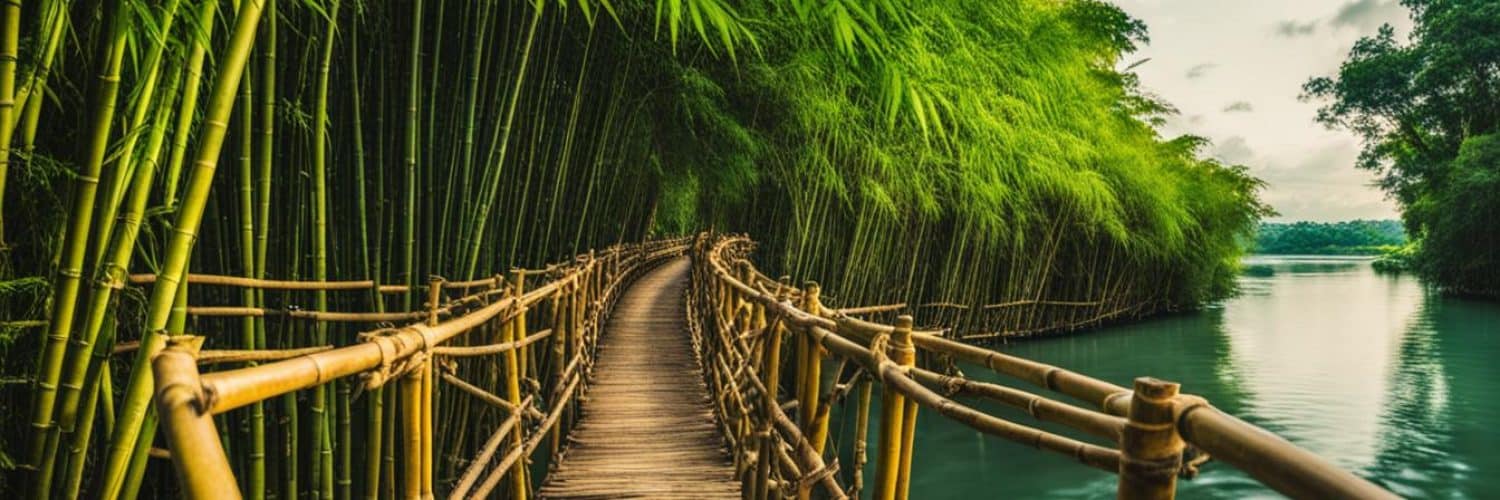Discover the beauty and adventure of the Bamboo Hanging Bridge in Bohol, Philippines. This iconic tourist attraction is located in the charming town of Sevilla and offers a unique experience filled with traditional architecture and breathtaking views.
The Bamboo Hanging Bridge is made of sturdy bamboo and steel cables, providing a safe crossing for both locals and tourists. As you step onto the bridge, you’ll be surrounded by lush greenery and the soothing sound of the Sipatan River flowing beneath. It’s a truly immersive nature experience that will leave you in awe of Bohol’s natural wonders.
To enhance your visit, try crossing the bridge early in the morning when the crowd is smaller, allowing you to enjoy a more peaceful experience. The bouncing sensation as you walk across adds an extra touch of adventure to this remarkable attraction.
Open 24/7, the Bamboo Hanging Bridge welcomes visitors at any time of the day. There is an entrance fee of 35 PHP per person, which goes towards the maintenance of the bridge and preserving its cultural significance.
Key Takeaways:
- Visit the Bamboo Hanging Bridge in Bohol, Philippines for a unique and adventurous experience.
- Enjoy the traditional architecture and scenic views of the bridge, made of bamboo and steel cables.
- Opt for an early morning visit to have a more peaceful and less crowded experience.
- Don’t miss the bouncing sensation as you cross the bridge, adding to the thrill.
- Open 24/7, the bridge has an entrance fee of 35 PHP per person.
What to Expect at the Bamboo Hanging Bridge
The Bamboo Hanging Bridge is an enchanting attraction that offers a thrilling nature experience and showcases traditional architecture. Consisting of two bridges, one for each direction, it gracefully spans the Sipatan River, providing breathtaking views of the surrounding natural beauty.
Despite its seemingly precarious appearance, the Bamboo Hanging Bridge is actually safe to cross. In fact, locals use it on a daily basis, and you might even spot motorcycles crossing over. The bridge’s support cables are made of sturdy steel, ensuring stability and peace of mind for visitors.
As you traverse the bridge, you’ll be delighted by the bouncing sensation beneath your feet, adding an extra touch of adventure to your experience. Alongside the bridge, you’ll find stores offering snacks and refreshments, including the chance to savor the refreshing taste of fresh coconuts.
In short, the Bamboo Hanging Bridge promises an unforgettable nature encounter, combined with the opportunity to appreciate traditional architecture. It’s an adventure that immerses you in the beauty of the surroundings while capturing the essence of Filipino culture.
Opening Hours and Entrance Fee of the Bamboo Hanging Bridge
The Bamboo Hanging Bridge is open 24/7, providing visitors with the flexibility to experience it at any time of the day. Whether you prefer an early morning adventure or a late-night stroll, this iconic attraction is accessible round the clock. So, no matter what time suits your schedule, you can immerse yourself in the mesmerizing beauty of the bridge and its surroundings.
To maintain the bridge and preserve its cultural significance, there is an entrance fee of 35 PHP per person during the day. This nominal fee contributes to the upkeep and conservation efforts carried out by the local authorities. Furthermore, it ensures that future generations can continue to enjoy the rich heritage of the Bamboo Hanging Bridge.
Children under 9 years old can enter for free, making it a family-friendly destination. Whether you’re traveling solo or visiting with loved ones, the Bamboo Hanging Bridge offers an enchanting experience for every age group.
| Opening Hours | Entrance Fee |
|---|---|
| 24/7 | 35 PHP per person (Free for children under 9) |
Experience the Bamboo Hanging Bridge, Bohol’s remarkable attraction, at any time of the day. Paying a small entrance fee helps maintain this cultural treasure while providing you with an unforgettable adventure.
How to Get to the Bamboo Hanging Bridge
Getting to the Bamboo Hanging Bridge is a straightforward journey that offers various transportation options. Whether you prefer a guided tour, renting a motorbike, or using public transportation, there are plenty of ways to reach this iconic attraction.
- By Ferry: Start your journey by taking a ferry from Cebu, Dumaguete, or Siquijor to Bohol. These islands are well connected and offer regular ferry services to Bohol, allowing you to easily reach the bridge.
- Guided Tours: If you prefer a hassle-free experience, joining a guided tour is a great option. Many tour operators in Bohol offer day trips that include a visit to the Bamboo Hanging Bridge, ensuring a smooth and convenient travel experience.
- Motorbike Rental: For those who enjoy the freedom of exploring at their own pace, renting a motorbike is recommended. There are numerous rental shops in Bohol where you can find a suitable motorbike for your journey to the bridge. Just remember to follow local traffic regulations and wear a helmet for your safety.
- Public Transportation: Alternatively, you can take buses or jeeps to reach the bridge. These modes of transportation are widely available in Bohol and offer a cost-effective way to travel. You can inquire about the nearest bus or jeepney terminal at your accommodation or ask the locals for directions.
Once you reach Bohol, the Bamboo Hanging Bridge is approximately 31 kilometers away from Tagbilaran City. The journey to the bridge takes around an hour, allowing you to enjoy the scenic views along the way.
Tip: If you’re unsure about the transportation options or need assistance planning your trip, don’t hesitate to ask the staff at your accommodation. They will be able to provide valuable advice and help you choose the best transportation option based on your preferences.
Now that you know how to get to the Bamboo Hanging Bridge, it’s time to embark on your adventure and experience the thrill of crossing this unique and picturesque attraction.
| Transportation Option | Pros | Cons |
|---|---|---|
| Ferry | Convenient and well-connected | Dependent on ferry schedules |
| Guided Tour | Hassle-free experience | Less flexibility in itinerary |
| Motorbike Rental | Freedom to explore at your own pace | Requires motorcycle driving skills |
| Public Transportation | Cost-effective option | May have limited schedules |
Witness the beauty of the Bamboo Hanging Bridge as you embark on a memorable journey through the scenic landscapes of Bohol. The bridge will leave you in awe of its traditional architecture and the lush greenery that surrounds it.
Plan your trip today and discover the wonders of the Bamboo Hanging Bridge in person!
Where to Stay on Bohol Island
Bohol Island offers a wide range of accommodation options to suit every traveler’s needs. Whether you’re a budget-conscious adventurer, a mid-budget explorer, or a luxury seeker, you’ll find the perfect place to stay on this beautiful island.
For Budget Travelers: Homaja Beach Resort
If you’re looking for a budget-friendly option that doesn’t compromise on comfort and location, Homaja Beach Resort is the place for you. Situated in a prime location, this resort offers stunning views and a friendly, welcoming atmosphere. The resort’s staff are dedicated to ensuring your stay is enjoyable and memorable.
For Mid-Budget Travelers: Mario Dive Resort
Mid-budget travelers will find Mario Dive Resort to be an excellent choice. This resort provides clean and spacious rooms equipped with great facilities. Located near popular attractions, it offers convenience without breaking the bank. After a day of exploration, you can relax and unwind in the comfort of your room.
For Luxury Travelers: North Zen Villas
If you’re seeking a luxurious experience, look no further than North Zen Villas. This upscale accommodation option offers breathtaking views, luxurious design, and excellent amenities. Immerse yourself in the tranquility of the surroundings while enjoying world-class service and comfort.
Choosing the right accommodation will enhance your overall experience of exploring Bohol Island and visiting the Bamboo Hanging Bridge. Whether you’re on a tight budget or looking to indulge in luxury, Bohol Island has the perfect place to call your home away from home.
History and Cultural Significance of Bamboo Bridges in the Philippines
Bamboo bridges hold a rich history and cultural significance in the Philippines. These bridges, locally known as “hangging,” are a testament to the Filipino people’s resourcefulness and architectural ingenuity. Constructed using sturdy bamboo poles, woven bamboo slats, and natural fiber ropes or vines, these bridges serve as vital transportation links in rural areas where infrastructure may be limited.
The construction of bamboo bridges showcases the sustainable solutions that the Filipino people have developed to adapt to their environment. These bridges not only facilitate safe passage across rivers and ravines but also embody the essence of Filipino architecture and design. The use of bamboo, a locally abundant and eco-friendly material, reflects the deep connection between the Filipino culture and the natural resources that surround them.
Furthermore, bamboo bridges serve as a symbol of communal effort and unity. The construction process often involves the entire community, with each member contributing their skills and knowledge to create a resilient and reliable structure. This collaborative effort highlights the value that Filipino society places on collective endeavors and the preservation of their cultural heritage.
“Bamboo bridges in the Philippines are not just engineering marvels; they represent the spirit of resilience and craftsmanship that has been handed down through generations.”
The Bamboo Hanging Bridge in Bohol is a prime example of the cultural heritage preserved within these architectural wonders. As visitors traverse the bridge, they are transported back in time, experiencing the traditional construction methods employed by Filipino ancestors. The bridge offers a glimpse into the local way of life, fostering an appreciation for the craftsmanship and resourcefulness of the Filipino people.
Preserving Cultural Heritage and Sustainable Solutions
The preservation of bamboo bridges is not only crucial for maintaining the cultural heritage of the Philippines but also for promoting sustainable solutions in modern times. These bridges demonstrate the eco-friendly and resilient nature of bamboo as a construction material, encouraging the exploration of alternative building methods that honor the environment.
By preserving and maintaining bamboo bridges, future generations can continue to appreciate the ingenuity of Filipino architecture while also gaining insight into sustainable engineering practices. The popularity of the Bamboo Hanging Bridge in Bohol serves as a reminder of the importance of safeguarding these cultural treasures and integrating them into contemporary discussions surrounding eco-friendly infrastructure.
Visiting Tips for the Bamboo Hanging Bridge
When visiting the Bamboo Hanging Bridge, it’s important to prioritize safety and take necessary precautions to ensure a pleasant and secure experience. Here are some tips to help you make the most of your visit:
- Keep a safe distance: The bridge may sway slightly under the weight of pedestrians, but rest assured, it is secure to cross. To maintain stability and prevent overcrowding, it’s advisable to maintain a safe distance from other visitors.
- Avoid abrupt movements: While crossing the bridge, it’s best to avoid sudden or rapid movements that could potentially disrupt the balance or cause discomfort to other pedestrians. Take your time, embrace the bouncing sensation, and enjoy the adventure.
- Respect other visitors: The Bamboo Hanging Bridge is a popular attraction, and chances are you’ll encounter other people crossing as well. Be considerate and mindful of their presence when taking photographs or admiring the scenery.
- Support the local community: Near the bridge, you’ll find stalls selling souvenirs and local delicacies. Show your appreciation for the community by purchasing some unique keepsakes or trying out the delicious food. Your support contributes to the local economy and helps preserve their way of life.
- Choose the best time to visit: To enjoy the Bamboo Hanging Bridge without the inconvenience of rain or large crowds, it’s recommended to plan your visit between November and April. During this period, the weather in the Philippines is generally drier, allowing for a more enjoyable experience.
“The bridge may sway slightly under the weight of pedestrians, but it is secure to cross.”
By following these visiting tips, you can ensure a safe, memorable, and respectful experience at the Bamboo Hanging Bridge.
Sunset and sunrise hours at the Bamboo Hanging Bridge
| Month | Sunrise Time | Sunset Time |
|---|---|---|
| November | 5:35 AM | 5:26 PM |
| December | 5:47 AM | 5:32 PM |
| January | 5:56 AM | 5:42 PM |
| February | 6:06 AM | 5:52 PM |
| March | 6:13 AM | 5:58 PM |
| April | 6:10 AM | 5:59 PM |
Witnessing the sunrise or sunset at the Bamboo Hanging Bridge can add a touch of magic to your visit. Use the table above as a reference to plan your visit during these beautiful moments of the day.
Attractions Near the Bamboo Hanging Bridge
When visiting the Bamboo Hanging Bridge in Bohol, Philippines, there are several attractions nearby that visitors can explore to enhance their experience. These attractions offer a diverse range of activities and sights, providing a comprehensive glimpse into Bohol’s natural wonders and cultural heritage.
Loboc River Cruise
The Loboc River Cruise is a popular activity among tourists, offering a unique and enjoyable experience. Visitors can enjoy a buffet meal while cruising along the picturesque Loboc River. The serene surroundings and lush greenery create a tranquil ambiance, providing the perfect setting to relax and appreciate the beauty of nature. With live music and entertaining performances on board, the Loboc River Cruise guarantees a memorable and enjoyable time for all.
Tarsier Sanctuary
For those interested in wildlife and conservation, the Tarsier Sanctuary in Corella is a must-visit attraction. The sanctuary is dedicated to the preservation and protection of the endangered Philippine tarsiers, the world’s smallest primates. Visitors have the opportunity to see these adorable creatures up close in their natural habitat. The knowledgeable guides provide insightful information about the tarsiers and their conservation efforts, making the experience both educational and exciting.
Man-Made Forest
The Man-Made Forest is another noteworthy attraction near the Bamboo Hanging Bridge. This expansive forested area is a testament to environmental conservation and protection. The towering mahogany trees create a mesmerizing canopy that stretches for kilometers, providing a cool and refreshing escape from the tropical heat. Taking a leisurely stroll or capturing stunning photographs amidst this majestic forest is a must-do activity for nature lovers.
Adventure Park
Thrill-seekers will find plenty of excitement at the nearby Adventure Park. This adrenaline-packed destination offers a wide range of thrilling activities, including ziplining, cable car rides, and rope courses. With stunning views of the surrounding landscape, visitors can experience an exhilarating rush of adrenaline while enjoying the beauty of their surroundings. The Adventure Park is suitable for all ages and guarantees a fun-filled day of adventure and excitement.
Historical Sites and Local Cuisine
In addition to the natural attractions, visitors can also explore the rich history and local culture of Bohol. The province is home to numerous historical sites, such as the Blood Compact Shrine, Baclayon Church, and the Chocolate Hills. These sites showcase Bohol’s vibrant past and provide insights into its cultural heritage. Moreover, indulging in the local cuisine is a must-do when exploring the area. From fresh seafood to traditional Filipino dishes, Bohol offers a delectable culinary experience that shouldn’t be missed.
Exploring these attractions near the Bamboo Hanging Bridge will provide visitors with a well-rounded experience of Bohol’s natural wonders, cultural heritage, and adventurous spirit. Whether it’s cruising along the Loboc River, observing tarsiers in their natural habitat, adventuring at the park, or immersing in history and local flavors, there’s something for everyone to enjoy near the Bamboo Hanging Bridge.
Importance of Sustainable Tourism at the Bamboo Hanging Bridge
Sustainable tourism plays a vital role in preserving the cultural heritage and natural beauty of destinations like the Bamboo Hanging Bridge in Bohol, Philippines. By embracing eco-friendly practices and responsible travel, visitors can contribute to the conservation efforts and ensure the long-term enjoyment of this iconic landmark.
Preserving the cultural heritage is an essential aspect of sustainable tourism. The Bamboo Hanging Bridge showcases Filipino architecture and traditional construction methods, and its preservation helps to maintain the cultural identity of the local community. By respecting the bridge and the surrounding environment, visitors can actively participate in preserving this cultural treasure.
Responsible travel practices also include minimizing waste and supporting local businesses. Visitors can bring reusable water bottles to reduce plastic waste and dispose of any trash properly. By purchasing souvenirs from local artisans and enjoying meals at nearby eateries, travelers can directly contribute to the economic development of the community.
“Sustainable tourism is not only about preserving the environment but also about respecting the local culture and improving the well-being of the communities we visit.” – Bamboo Traveler Magazine
Treating the bridge and the surrounding nature with care is crucial for its preservation. Visitors should avoid defacing the bridge or littering in the area. It is essential to stay on the designated paths and avoid causing any damage to the natural environment. By practicing responsible behavior, visitors can help maintain the ecological balance and ensure the sustainability of the Bamboo Hanging Bridge.
By embracing sustainable tourism practices, visitors can have a positive impact on the preservation of the Bamboo Hanging Bridge and the cultural heritage it represents. Through mindful actions and respect for the environment, travelers can contribute to the long-term sustainability of this iconic attraction for future generations to enjoy.
Key Takeaways:
- Sustainable tourism is crucial for preserving the cultural heritage and natural beauty of destinations like the Bamboo Hanging Bridge.
- Responsible travel practices include minimizing waste, supporting local businesses, and treating the bridge and surrounding nature with care.
- By embracing sustainable tourism, visitors can actively contribute to the preservation efforts and ensure the enjoyment of the Bamboo Hanging Bridge for future generations.
Conclusion
The Bamboo Hanging Bridge in Bohol, Philippines is a must-visit destination for nature enthusiasts and adventure seekers. This unique tourist attraction not only offers a thrilling experience but also provides a glimpse into the cultural heritage of the country. With its traditional architecture and breathtaking views of the surrounding nature, the bridge is easily accessible and open 24/7 for visitors to explore.
When visiting the Bamboo Hanging Bridge, it is important to follow safety precautions and support the local community. The bridge may sway slightly, but it is safe to cross, allowing visitors to enjoy the bouncing sensation and capture memorable photos. It is recommended to visit early in the morning to avoid crowds and fully immerse in the serene atmosphere.
Preserving the Bamboo Hanging Bridge for future generations is essential. By practicing sustainable tourism, such as minimizing waste and supporting local businesses, visitors can contribute to the preservation of this iconic landmark. Additionally, exploring the nearby attractions, such as the Loboc River Cruise and Tarsier Sanctuary, will enhance the overall experience of Bohol Island and create lasting memories.
In conclusion, a visit to the Bamboo Hanging Bridge offers an unforgettable adventure and a deeper understanding of the rich cultural heritage of the Philippines. Combining natural beauty, cultural significance, and sustainable tourism practices, this attraction captures the essence of Bohol Island, making it a must-see destination for all travelers.
FAQ
Is the Bamboo Hanging Bridge safe to cross?
Yes, the Bamboo Hanging Bridge is safe to cross. It may sway slightly under the weight of pedestrians, but it is secure and regularly used by locals and even motorcycles.
What are the opening hours of the Bamboo Hanging Bridge?
The Bamboo Hanging Bridge is open 24/7, allowing visitors to experience it at any time of the day.
How much is the entrance fee to the Bamboo Hanging Bridge?
There is an entrance fee of 35 PHP per person to access the Bamboo Hanging Bridge during the day. Children under 9 years old have free admission.
How do I get to the Bamboo Hanging Bridge?
Where should I stay on Bohol Island?
There are various accommodation options on Bohol Island. Budget travelers can consider Homaja Beach Resort, while mid-budget travelers can choose Mario Dive Resort. Luxury travelers can indulge in North Zen Villas for a luxurious experience.
What is the history and cultural significance of bamboo bridges in the Philippines?
Bamboo bridges, known as “hangging,” are an integral part of the cultural and architectural heritage of the Philippines. They are traditionally built using bamboo poles, woven slats, and natural fiber ropes or vines, showcasing the resourcefulness and ingenuity of the Filipino people.
What are some visiting tips for the Bamboo Hanging Bridge?
When visiting the Bamboo Hanging Bridge, it is important to take safety precautions such as keeping a safe distance from others and avoiding abrupt movements. Visitors can also support the local community by purchasing souvenirs or trying local food from nearby stalls.
What attractions are near the Bamboo Hanging Bridge?
Near the Bamboo Hanging Bridge, visitors can explore attractions such as the Loboc River Cruise, Tarsier Sanctuary, Man-Made Forest, Adventure Park, historical sites, and enjoy local cuisine.
How important is sustainable tourism at the Bamboo Hanging Bridge?
Sustainable tourism plays a crucial role in preserving the cultural heritage and natural beauty. By following responsible travel practices such as minimizing waste, supporting local businesses, and treating the bridge and surrounding nature with care, visitors can contribute to the preservation of the Bamboo Hanging Bridge.

















Add comment